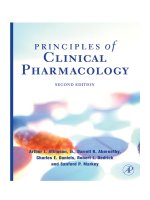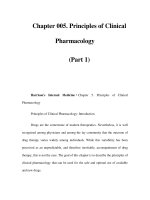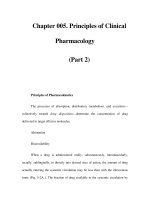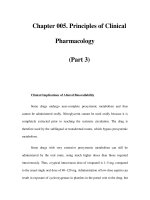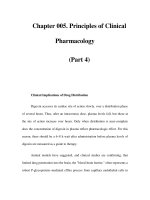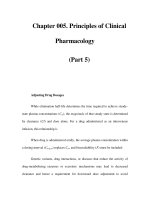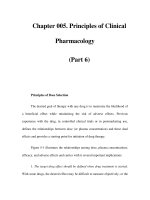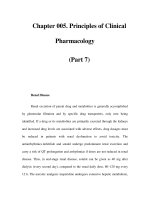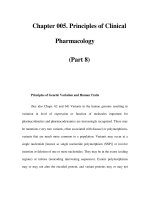Chapter 005. Principles of Clinical Pharmacology (Part 1) pps
Bạn đang xem bản rút gọn của tài liệu. Xem và tải ngay bản đầy đủ của tài liệu tại đây (14.77 KB, 5 trang )
Chapter 005. Principles of Clinical
Pharmacology
(Part 1)
Harrison's Internal Medicine > Chapter 5. Principles of Clinical
Pharmacology
Principles of Clinical Pharmacology: Introduction
Drugs are the cornerstone of modern therapeutics. Nevertheless, it is well
recognized among physicians and among the lay community that the outcome of
drug therapy varies widely among individuals. While this variability has been
perceived as an unpredictable, and therefore inevitable, accompaniment of drug
therapy, this is not the case. The goal of this chapter is to describe the principles of
clinical pharmacology that can be used for the safe and optimal use of available
and new drugs.
Drugs interact with specific target molecules to produce their beneficial and
adverse effects. The chain of events between administration of a drug and
production of these effects in the body can be divided into two components, both
of which contribute to variability in drug actions. The first component comprises
the processes that determine drug delivery to, and removal from, molecular
targets. The resultant description of the relationship between drug concentration
and time is termed pharmacokinetics. The second component of variability in drug
action comprises the processes that determine variability in drug actions despite
equivalent drug delivery to effector drug sites. This description of the relationship
between drug concentration and effect is termed pharmacodynamics. As discussed
further below, pharmacodynamic variability can arise as a result of variability in
function of the target molecule itself or of variability in the broad biologic context
in which the drug-target interaction occurs to achieve drug effects.
Two important goals of the discipline of clinical pharmacology are (1) to
provide a description of conditions under which drug actions vary among human
subjects; and (2) to determine mechanisms underlying this variability, with the
goal of improving therapy with available drugs as well as pointing to new drug
mechanisms that may be effective in the treatment of human disease. The first
steps in the discipline were empirical descriptions of the influence of disease X on
drug action Y or of individuals or families with unusual sensitivities to adverse
drug effects. These important descriptive findings are now being replaced by an
understanding of the molecular mechanisms underlying variability in drug actions.
Thus, the effects of disease, drug coadministration, or familial factors in
modulating drug action can now be reinterpreted as variability in expression or
function of specific genes whose products determine pharmacokinetics and
pharmacodynamics. Nevertheless, it is the personal interaction of the patient with
the physician or other health care provider that first identifies unusual variability
in drug actions; maintained alertness to unusual drug responses continues to be a
key component of improving drug safety.
Unusual drug responses, segregating in families, have been recognized for
decades and initially defined the field of pharmacogenetics. Now, with an
increasing appreciation of common polymorphisms across the human genome,
comes the opportunity to reinterpret descriptive mechanisms of variability in drug
action as a consequence of specific DNA polymorphisms, or sets of DNA
polymorphisms, among individuals. This approach defines the nascent field of
pharmacogenomics, which may hold the opportunity of allowing practitioners to
integrate a molecular understanding of the basis of disease with an individual's
genomic makeup to prescribe personalized, highly effective, and safe therapies.
Indications for Drug Therapy
It is self-evident that the benefits of drug therapy should outweigh the risks.
Benefits fall into two broad categories: those designed to alleviate a symptom and
those designed to prolong useful life. An increasing emphasis on the principles of
evidence-based medicine and techniques such as large clinical trials and meta-
analyses have defined benefits of drug therapy in specific patient subgroups.
Establishing the balance between risk and benefit is not always simple: for
example, therapies that provide symptomatic benefits but shorten life may be
entertained in patients with serious and highly symptomatic diseases such as heart
failure or cancer. These decisions illustrate the continuing highly personal nature
of the relationship between the prescriber and the patient.
Some adverse effects are so common and so readily associated with drug
therapy that they are identified very early during clinical use of a drug. On the
other hand, serious adverse effects may be sufficiently uncommon that they escape
detection for many years after a drug begins to be widely used. The issue of how
to identify rare but serious adverse effects (that can profoundly affect the benefit-
risk perception in an individual patient) has not been satisfactorily resolved.
Potential approaches range from an increased understanding of the molecular and
genetic basis of variability in drug actions to expanded postmarketing surveillance
mechanisms. None of these have been completely effective, so practitioners must
be continuously vigilant to the possibility that unusual symptoms may be related to
specific drugs, or combinations of drugs, that their patients receive.
Beneficial and adverse reactions to drug therapy can be described by a
series of dose-response relations (Fig. 5-1). Well-tolerated drugs demonstrate a
wide margin, termed the therapeutic ratio, therapeutic index, or therapeutic
window, between the doses required to produce a therapeutic effect and those
producing toxicity. In cases where there is a similar relationship between plasma
drug concentration and effects, monitoring plasma concentrations can be a highly
effective aid in managing drug therapy by enabling concentrations to be
maintained above the minimum required to produce an effect and below the
concentration range likely to produce toxicity. Such monitoring has been widely
used to guide therapy with specific agents, such as certain antiarrhythmics,
anticonvulsants, and antibiotics. Many of the principles in clinical pharmacology
and examples outlined below, which can be applied broadly to therapeutics, have
been developed in these arenas.
